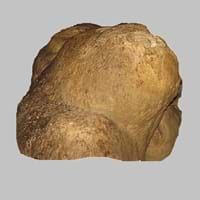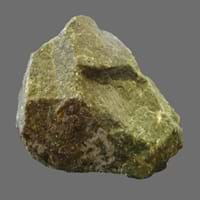Definition
Travertine is a mineral consisting of layered calcium carbonate formed by deposition from spring waters
Dunite is a green to brownish coarse-grained igneous rock mainly consisting of olivine
Discoverer
Marcus Vitruvius Pollio
Ferdinand von Hochstetter
Etymology
From Italian travertino a kind of building stone, from Tiburs, adjective from Tibur (Tivoli), in Italy
From the name of Dun Mountain, New Zealand, + -ite1
Class
Sedimentary Rocks
Igneous Rocks
Sub-Class
Durable Rock, Medium Hardness Rock
Durable Rock, Medium Hardness Rock
Group
Not Applicable
Plutonic
Other Categories
Fine Grained Rock, Opaque Rock
Coarse Grained Rock, Opaque Rock
Texture
Banded
Phaneritic
Color
Beige, Black, Blue, Brown, Grey, Red, White, Yellow
Dark Greenish - Grey
Durability
Durable
Durable
Scratch Resistant
Yes
Yes
Appearance
Fibrous
Rough and Shiny
Interior Uses
Decorative Aggregates, Entryways, Flooring, Homes, Interior Decoration
Decorative Aggregates, Interior Decoration
Exterior Uses
As Building Stone, As Facing Stone, Paving Stone, Garden Decoration, Office Buildings
As Building Stone, As Facing Stone, Garden Decoration, Paving Stone
Other Architectural Uses
Curbing
Curbing
Construction Industry
As Dimension Stone, Building houses or walls, Cement Manufacture, Construction Aggregate, for Road Aggregate, Raw material for the manufacture of mortar
As Dimension Stone, Cement Manufacture, Construction Aggregate, for Road Aggregate, Making natural cement, Raw material for the manufacture of mortar
Medical Industry
Not Yet Used
Not Yet Used
Antiquity Uses
Artifacts, Jewellery, Monuments, Sculpture, Small Figurines
Artifacts, Monuments, Sculpture, Small Figurines
Commercial Uses
Cemetery Markers, Creating Artwork, Gemstone, Jewelry, Paper Industry, Pottery
Creating Artwork, Gemstone, Jewelry, Source of Chromite, Platinum, Nickel and Garnet, Source of Diamonds
Types
Not Available
Not Available
Features
Stalactites and stalagmites are formed from this rock, Surfaces are often shiny, Very fine grained rock
Constitutes upper part of the Earth's mantle, Generally rough to touch, Host rock for Diamond, Is one of the oldest rock
Archaeological Significance
Famous Monuments
Colosseum in Rome, Italy, Sacré Coeur in Paris, France, Trevi Fountain in Rome, Italy
Data Not Available
Famous Sculptures
Data Not Available
Data Not Available
Formation
Travertine is a type of sedimentary rock formed when a river carries or transports pieces of broken rock which then undergo sedimentation. They are then subjected to high temperature and pressure hence forming travertine rock.
Dunite is a plutonic ultramafic igneous rock consisting almost m olivine. It can be formed in two ways.
Mineral Content
Calcite, Clay, Feldspar, Micas, Quartz
Amphibole, Chromite, Garnet, Magnesium, Olivine, Phlogopite, Plagioclase, Pyroxene
Compound Content
Ca, NaCl, CaO, Oxygen
Ca, CaO, Fe, Potassium, Silicon Dioxide, Sodium, Titanium Dioxide
Types of Metamorphism
Not Applicable
Burial Metamorphism, Cataclastic Metamorphism, Contact Metamorphism
Types of Weathering
Biological Weathering, Chemical Weathering, Mechanical Weathering
Biological Weathering, Chemical Weathering, Mechanical Weathering
Types of Erosion
Chemical Erosion, Coastal Erosion, Glacier Erosion
Coastal Erosion, Glacier Erosion, Water Erosion
Grain Size
Fine Grained
Coarse Grained
Fracture
Splintery
Irregular
Porosity
Highly Porous
Less Porous
Luster
Dull to Pearly
Shiny
Cleavage
Non-Existent
Imperfect
Specific Gravity
1.68
3-3.01
Transparency
Opaque
Translucent to Opaque
Density
2.71 g/cm3
2.84-2.85 g/cm3
Resistance
Impact Resistant, Pressure Resistant, Wear Resistant
Heat Resistant, Pressure Resistant, Wear Resistant
Deposits in Eastern Continents
Asia
China, Russia
China, India, Indonesia, Kazakhstan, Russia, South Korea, Thailand, Turkey
Africa
Not Yet Found
Morocco, South Africa
Europe
Austria, Italy, Portugal, United Kingdom
Finland, France, Georgia, Germany, Great Britain, Italy, Kazakhstan, Netherlands, Norway, Spain, Switzerland, Venezuela
Others
Not Yet Found
Not Yet Found
Deposits in Western Continents
North America
Canada, USA
Canada, USA
South America
Argentina, Bolivia, Ecuador
Argentina, Brazil, Colombia, Ecuador, Venezuela
Deposits in Oceania Continent
Australia
Not Yet Found
New Zealand, Western Australia
All about Travertine and Dunite Properties
Know all about Travertine and Dunite properties here. All properties of rocks are important as they define the type of rock and its application. Travertine belongs to Sedimentary Rocks while Dunite belongs to Igneous Rocks.Texture of Travertine is Banded whereas that of Dunite is Phaneritic. Travertine appears Fibrous and Dunite appears Rough and Shiny. The luster of Travertine is dull to pearly while that of Dunite is shiny. Travertine is available in beige, black, blue, brown, grey, red, white, yellow colors whereas Dunite is available in dark greenish - grey colors. The commercial uses of Travertine are cemetery markers, creating artwork, gemstone, jewelry, paper industry, pottery and that of Dunite are creating artwork, gemstone, jewelry, source of chromite, platinum, nickel and garnet, source of diamonds.










